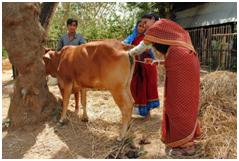Introduction
Artificial insemination (AI) is a technique in which sperm are collected from the male, processed, stored and artificially introduced into the female reproductive tract at proper time for the purpose of conception. AI has become one of the most important techniques ever devised for the genetic improvement of farm animals. It has been most widely used for breeding dairy cattle and buffalo.
History
The history of the development and use of artificial insemination in domestic animals is a long and varied one.
1300 A.D - The first reported use of AI, although not documented. In Arab countries artificial insemination was carried out in Arab horse breeders. According to an Arabian book published in 14th century; an Arab chief of Darfur put a ball of cotton in the vagina of a mare which was recently bred by a famous stallion belonging to an enemy cheiftan during night time. After 24 hours, he then hurried to home and introduced the cotton ball into vagina his own mare. The mare became pregnant and gave birth of a foal.
1677 - A major technological breakthrough in the study of reproductive physiology was made by a Dutch Scientist named van Leeuwenhoek, who developed a simple microscope. A medical student suggested to van Leeuwenhoek that semen might contain living cells using his microscope; van Leeuwenhoek observed semen and discovered that it contained small particles that moved about. He referred to these particles as “animalcules” and published a paper on his observations in 1677.
1780 - An Italian physiologist, Lazzaro Spallanzani reported first successful use of AI. After success with several amphibian animals, he started experiment with dog. Dogs were confined in his house. When one bitch manifested the signs of heat, he used semen at body temperature to inseminate the bitch. Sixty-two days later she gave birth to three pups. He is also called “Father of modern artificial insemination”.
1803 - Spallanzani reported cooling of semen prolong the sperm life. Further development did not occur for a very long time.
1914 - G. Amantia, professor of human physiology at University of Rome developed the first artificial vagina for collection of semen from dog.
1937 - Danish veterinarians developed the first rectovaginal/cervical fixation method of AI.
1940 - Philips and Lardy developed egg yolk phosphate diluter for preserving fertility and motility of refrigerated bull spermatozoa.
1941 - Salisbury et al. developed egg yolk citrate diluter.
1948 - Sorenson first time used large sized straws (12mm) made up of polyvinyl chloride.
1949 - Polge, Smith and Parkes discovered cryoprotective effect of glycerol in frozen semen technology. This is most important milestone in the history of artificial insemination.
1951 - Steward reported the birth of first calf from insemination with frozen semen in cooperation with Polge and Smith.
1963 - Nagase and Niwa developed the technique of freezing bull semen in pellet form in Japan.
1964 - Cassou improved the straws by reducing their size and named it as medium French straws. The size of the straw was 135 mm long and 2.8 mm diameter with 0.5 ml semen capacity.
1968 - Cassou further reduced the size of the straws to the diameter of 2 mm with a capacity of 0.25 ml and named it as mini French straws.
1974 - Japanese Scientist Nishekawa et al. first time frozen the semen in liquid helium at - 265 Degree C.
1972 - A plastic straw called mini tube or German straws or ‘Lanshut system’ was developed in Germany. These straws are sealed by metallic or glass or plastic balls.
1960 - Adler developed the first technique for freezing of semen in straws using liquid nitrogen vapour.
1939 - In India, first time, AI was done by Sampat Kumaran at "Palace Dairy Farm Mysore”. He inseminated large number of Halliker cows with semen of Holstein Friesian and got 33 cows pregnant.
1942 - A pilot project was started at Indian Veterinary Research Institute (IVRI) to study the feasibility of AI under the guidance of Dr. P. Bhattacharya with the team consisting of Dr. S.S. Prabhu, Dr. D.P. Mukherjee, Dr. S.N. Luktuke, Dr. A roy and Dr. Garjan Singh. This team approved that this technique could be used in Indian Condition since then, this technique has come into general use as a regular practice of breeding for cattle and buffaloes.
1942 - Four regional centers were established at Bangalore, Calcutta, Patna and Montgomery (Now in Pakistan) by Govt. of India.
1943 - The first buffalo calf through AI was born at the Allahabad Agricultural Institute.
1951-1956 - In the first five-year plan (1951-56) the Government of India introduced 150 key village centers to improve cattle and buffaloes in this country.
1956-1961 - The second five-year plan (1956-61) gave a boost to AI work by implanting it in 400 key village centers.
contributed by Pradeep Kumar, Dharmendra Kumar, Indrajeet Singh and Sunesh @ Central Institute for Research on Buffaloes














